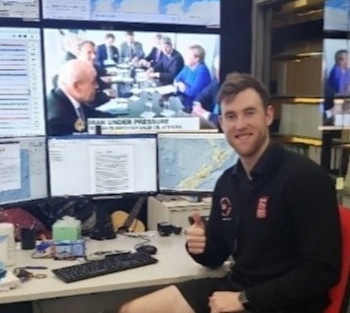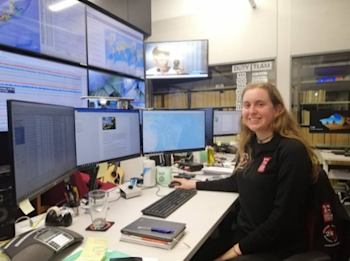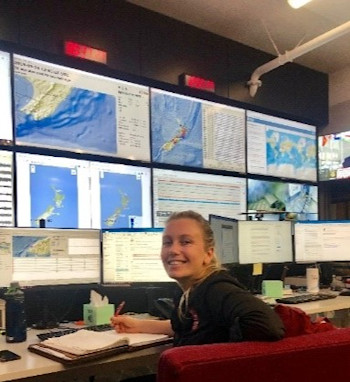
National Geohazards Monitoring Centre – Behind the screens
In the first of our behind-the-scenes series looking at the National Geohazards Monitoring Centre in the lead up to its one-year anniversary in December, we get to know three of the Centre’s Geohazard Analysts.
The National Geohazards Monitoring Centre (NGMC) is a purpose-built facility providing around-the-clock monitoring of tsunami, volcano, earthquake and landslide hazards to help keep New Zealanders safe. The centre is staffed by 15 geohazard analysts (GHAs) who are in teams of three (named after colours) and work in one of three shifts over a 24hr period.
Karl Wright – Purple Team 6am-2pm
Karl grew up in New Plymouth and studied geophysics and earth science at the University of Auckland, before moving down to Wellington to become a Geohazard Analyst at the NGMC.
The most exciting event that has happened whilst I was on shift was a M7.0 earthquake that struck Raoul Island (~1000km NE of Whangarei). We initiated a full response and located the earthquake in less than a few minutes. A tsunami was observed on mainland New Zealand (though it was only large enough to produce a slightly stronger current than normal) – the first and only one observed in New Zealand since the opening of the NGMC!
For me, the best thing about working as a Geohazard Analyst is the chance to work in the forefront of hazard monitoring in New Zealand. We are the first group of people to know about events and are the first to respond to such events. The work we do has the potential to save lives, which gives me a sense of pride and a drive that I haven’t experienced anywhere else. The shift work has its ups and downs, but my flatmates are definitely envious of my 4-day weekends!
Rose Dohig – Red Team 2pm-10pm
Rose grew up in New Plymouth and then moved to Wellington to study geology at Victoria University. Rose then travelled around New Zealand before moving down to South Westland to work as a nature guide. She spent a year taking people for hiking tours around Franz Josef and Fox glaciers and, as fun as that was, she couldn’t turn down the opportunity to work for GeoNet so moved back to Wellington to start work as a GHA. Funnily enough, Rose found out about this job by bumping into one of the GeoNet field technicians on the street in Franz Josef where they were servicing some of the network.
One interesting event I have been involved with is the recent M5.2 earthquake in Taupo. This was an interesting event as it generated a lot of public interest because it was so widely felt and located in a volcanic region. I was on earthquake locating duty when it happened, and I saw that the seismic waves recorded at the seismometers nearest to the epicenter were ‘clipped’, meaning they were experiencing strong shaking and the instruments had become overloaded. This was only the second time I had seen this from an earthquake I have located in real time. There’s also more pressure in these events as we know so many people have felt it, and we want to get a good solution up on the GeoNet website as soon as possible.
I really like the team culture we have here, and I get on very well with my team mates and the wider staff. I find a lot of fulfilment in doing a job that I know benefits the safety of New Zealanders. Being a GHA has not only expanded my interest in geology but has also helped me find an interest in emergency management, which has opened up a whole new world to me.
Kim Presow – Green Team 10pm-6am
Kim grew up in Wairarapa and studied Earth Science and Geography at Massey University in Palmerston North. Following university Kim had a variety of jobs including dairy farming, shepherding, baker, show jumping groom and an operations geologist. Those jobs were spread across New Zealand, Ireland, Canada and Australia!
Everything is interesting in here, we had a swarm near Mt Tarawera which resulted in the most earthquakes during one shift since the centre opened, 107 in total. This swarm had very small earthquakes every 1 to 2 minutes at times, our boss had pizza delivered to us as we didn’t even have time to eat.
We work across so many disciplines and so many groups within GNS Science, including with external stakeholders that there is always something interesting happening. The potential for more growth and taking on challenges is always present. Alongside that we get to have a strong operational focus and learn to work under significant pressures when we exercise our equipment, and ourselves. We’ve had many practise scenarios of large local earthquakes and distant earthquakes causing tsunamis.
I enjoy the variety in the shifts, rather than your normal 9am – 5pm, Monday-Friday. I like the monitoring and the projects that flow in and out of the NGMC. Learning from world-renowned scientists and being able to work in a growing and evolving entity is very exciting. We have a great team culture and spend lots of time together socially, as well as at work.
The NGMC builds on decades of work GNS Science has done with the Earthquake Commission (EQC) and Land Information New Zealand (LINZ). The support of our partners MBIE, MCDEM, EQC and LINZ has made the centre possible.






